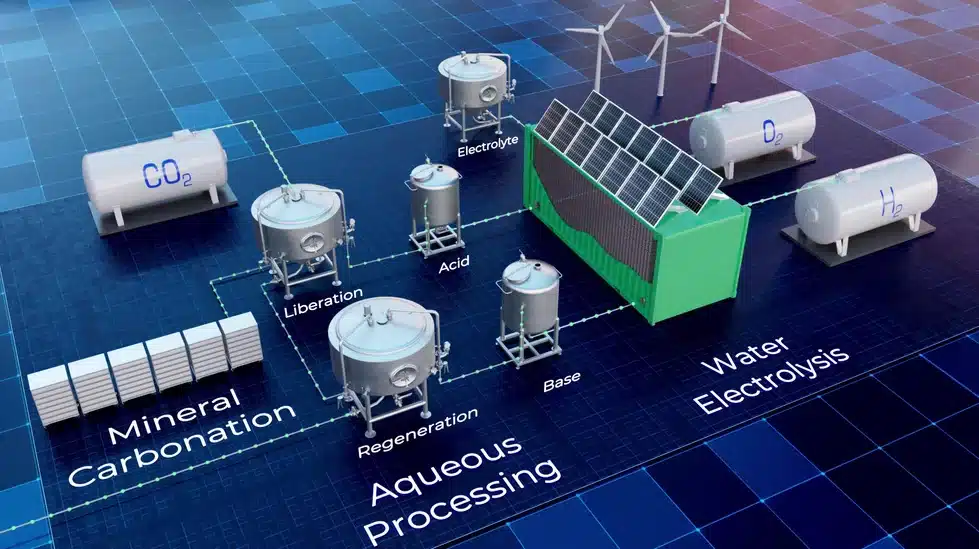Debate surrounds the challenge of mitigating emissions from hard-to-abate sectors to achieve net zero by 2050. Critics argue the short-term cost of such measures might be high, preferring more effective decarbonization routes.
Carbon removal startup Parallel Carbon claims its pioneering technology addresses both challenges by capturing CO2 directly from the air while generating low-cost green hydrogen.
The company aims to launch a kilowatt-scale demonstration project by 2025, with carbon removal credits (CDR) already pre-sold. The credits sold covered the startup’s first year of operations, helping them get off the ground and build the project.
How Parallel Carbon’s Dual Technology Work
Parallel Carbon’s technology employs hyper-reactive minerals and achieves both carbon removal for under $100 per ton of CO2 and clean hydrogen production for $1 per kilogram. Their approach combines Direct Air Capture (DAC) and Water Electrolysis processes, powered by solar and wind energy.
Beyond providing durable carbon storage, this approach generates high-quality CDR credits and green hydrogen to facilitate industrial decarbonization. Here’s the company’s technology in an overview.
Their electrolyzer produces hydrogen by splitting a neutral-salt electrolyte into an acid and an alkali without generating chlorine gas. This system works similarly with the chlor-alkali process, minus the chlorine gas.
Simultaneously, a mineral sorbent in DAC extracts CO2 from the atmosphere, releasing it by dissolving in the acid. This captured CO2 can either be stored geologically or used in industrial processes. The sorbent is then regenerated with the alkali for subsequent CO2 capture.
Notably, though the electrolyzer may operate intermittently, surplus acids and alkalis sustain the mineral sorbent’s recycling. This ensures continuous direct air capture even during renewable power unavailability.
Addressing DAC Efficiency and Cost Challenges
Parallel Carbon’s CEO Ryan Anderson highlights their technology’s flexibility, designed as a flexible industrial load operating on intermittent power. This aligns with clean hydrogen production tax credit requirements, ensuring minimal marginal electricity emissions for direct air capture’s carbon accounting.
Though this technology demands more energy input than conventional electrolyzers due to the simultaneous DAC, its reliance on low power prices potentially poses a challenge.
Estimated energy costs for this process, with renewable electricity at $30/MWh, amount to $1.50 per kg of H2 and $50 per tonne of CO2. Anderson foresees flexibility in cost allocation between hydrogen production and CO2 capture due to the dual product nature. He further noted that:
“For most direct air capture, operating with clean power is a necessity — I think that’s very challenging for other direct air capture technologies…over 90% of the energy for the process goes into the electrolyzer.”
They target a cost of $400/tonne of CO2 captured and $2/kg of H2 produced by the late 2020s. They also intend to further lower costs to $100 and $1, respectively, by the early 2030s.
The startup, having secured $3.6 million in seed funding led by Aramco Ventures, aims to field-test a scaled stack producing 50 kg of hydrogen and capturing one tonne of CO2 daily by early 2025.
Parallel Carbon has pre-sold its carbon dioxide removal credits for operations beginning in 2025. As corporations eye 2030 climate targets, the voluntary carbon market has gained traction, although scrutiny surrounds carbon removal effectiveness.
Driving Costs Down and Ambitions Up
Apart from the growing carbon credit market, DAC also largely benefits from highly lucrative government support in the United States.
Anderson emphasizes the measurable CO2 removal capability of direct air capture, ensuring high-quality climate action. However, he doubts industries’ preference for carbon removal over other decarbonization methods. Anderson had formerly worked as an analyst on carbon capture and storage for research firm BloombergNEF.
This skepticism is fueled partly by the expectation that the market will have a relatively limited quantity of high-quality credits available over the next 10-15 years.
Moreover, government subsidies like the 45Q tax credit incentivize carbon capture. Despite complexities in claiming multiple credits, Anderson sees potential for separate companies to leverage distinct tax credits.
The 45Q tax credit offers incentives of $85 per tonne of CO2 for point-source carbon capture that’s permanently stored. It would be $60 if the gas is used in industry or for enhanced oil recovery.
Then the credit increases significantly to $180 (or $130) if the capture is from direct air capture. But for DAC to qualify for these incentives, it needs to capture a minimum of 1,000 tonnes of CO2 annually.
Anderson also estimates that even without subsidies, carbon credits from DAC are currently sold for over $600/tonne of CO2.
Looking ahead, Parallel Carbon eyes a commercial pilot in 2026 capable of 100 tonnes hydrogen production and 1,000-2,000 tonnes of CO2 capture a year. The DAC company is also planning a Series A fundraising round to propel its vision forward.
Parallel Carbon pioneers technology that captures CO2 from the air, generating low-cost green hydrogen while directly addressing emissions challenges. Their innovative approach offers durable carbon storage and facilitates industrial decarbonization. With promising advancements and investments, they aim to revolutionize carbon removal and hydrogen production, positioning themselves at the forefront of sustainable innovation.



